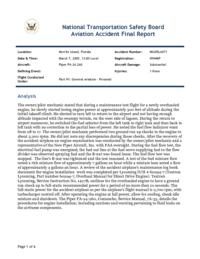
ASN Wikibase Occurrence # 294043
This information is added by users of ASN. Neither ASN nor the Flight Safety Foundation are responsible for the completeness or correctness of this information.
If you feel this information is incomplete or incorrect, you can submit corrected information.
| Date: | Monday 7 March 2005 |
| Time: | 14:00 LT |
| Type: |  Piper PA-24-260 |
| Owner/operator: | Kenneth Rivard |
| Registration: | N9446P |
| MSN: | 24-4954 |
| Year of manufacture: | 1970 |
| Total airframe hrs: | 4845 hours |
| Engine model: | Lycoming IO-540 |
| Fatalities: | Fatalities: 0 / Occupants: 1 |
| Aircraft damage: | Substantial |
| Category: | Accident |
| Location: | Merritt Island, Florida -
 United States of America United States of America
|
| Phase: | Unknown |
| Nature: | Private |
| Departure airport: | Cocoa-Merritt Island Airport, FL (COI/KCOI) |
| Investigating agency: | NTSB |
| Confidence Rating: |
The owner/pilot mechanic stated that during a maintenance test flight for a newly overhauled engine, he slowly started losing engine power at approximately 300 feet of altitude during the initial takeoff climb. He elected to turn left to return to the airport and not having enough altitude impacted with the swampy terrain, on the west side of lagoon. During the return to airport maneuver, he switched the fuel selector from the left tank to right tank and then back to left tank with no correction to the partial loss of power. He noted the fuel flow indicator want from 28 to 17. The owner/pilot mechanic performed two ground run up checks to the engine to about 2,200 rpms. He did not note any discrepancies during those checks. After the recovery of the accident airplane an engine examination was conducted by the owner/pilot mechanic and a representative of the New Piper Aircraft, Inc. with FAA oversight. During the fuel flow test, the electrical fuel pump was energized; the fuel out line at the fuel servo supplying fuel to the flow divider was observed spraying fuel and the B-nut was found loose. The fuel flow test was stopped. The line's B-nut was tightened and the test resumed. A test of the fuel mixture flow noted a rich mixture flow of approximately 7 gallons an hour while a mixture lean noted a flow of approximately 4 gallons an hour. A review of the accident airplane's maintenance log book document the engine installation work was completed per Lycoming O/H # 60294-7 (Textron Lycoming, Part number 60294-7, Overhaul Manual for Direct Drive Engine). Textron Lycoming, Service Instruction No. 1427B, outlines for the overhauled engine to have a ground run check up to full-static recommended power for a period of no more then 10 seconds. The full-static power for the accident airplane as per the airplane's flight manual is 2,700 rpm, with turbocharger control off. After operating the engine at full power, allow for cooling, check idle mixture and shutdown. The Piper PA-24-260, Comanche, Service Manual, 7A-33, details the procedures for engine installation; including cautions and warning pertaining to fluid leaks on the airframe components.
Probable Cause: The owner/pilot/mechanics inadequate installation of a fuel line resulting in a fuel leak, partial loss of engine power, and force landing in swampy terrain.
Accident investigation:
 |
|
Sources:
NTSB MIA05LA071
Revision history:
| Date/time | Contributor | Updates |
|---|---|---|
| 10-Oct-2022 16:35 | ASN Update Bot | Added |
Corrections or additions? ... Edit this accident description
The Aviation Safety Network is an exclusive service provided by:


 ©2024 Flight Safety Foundation
©2024 Flight Safety Foundation